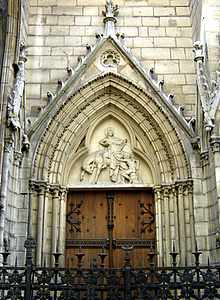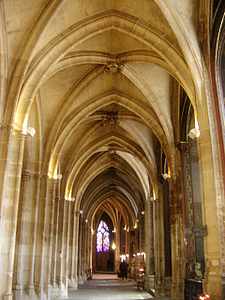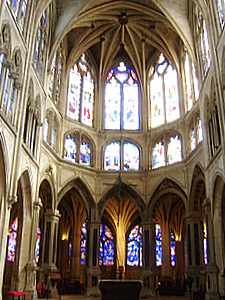Church of St. Severin The Solitaire

Church of St. Severin
Metro: Saint Michel
RER: Saint Michel-Notre Dame
Arrondissement: 5eme
Go Here For Hotels In This Area
Map of the Area
On the Left Bank, across from the Cathedral Notre Dame, and a few steps down rue St. Jaques, is the Church of St. Severin, The Solitaire.
Its history begins in the 6th century when Clodald, the future Saint Cloud, escaped the massacres of his uncles Childebert and Clotaire in 524. Clodald built a monastery and became a disciple of the hermit Severin.
The oratory of the hermitage was destroyed by the Normans. A chaple was built in its place in the 11th century and it became the church of an immense parish, comprising nearly all of the southern part of Paris.
The oldest remaining parts of the Church of St. Severin are the bell-tower and the first three spans of the nave, dating from the 13th century. The rest of the church dates from the second-half of the 15th century.
The tower ends in a sharp steeple, decorated with dormer windows, capped with a lantern, whose point can be seen along the quays of the Seine river.
The traditional main entrance, now usually closed, is under the tower and opens on to rue Saint Severin.
It has a columned porch with the remains of an inscription in small Gothic letters dating to the 13th century. On the right and left, are two reliefs of lions.

Saint Martin of Tours was one of the chief patrons of the parish church of St. Severin and there is a bas-relief of him in the arch above the main door.
Saint Martin is always represented mounted on horseback. He was the protector of travelers.
When setting out upon voyages, or upon their return, it was a custom to come to the church of St. Severin and attach a horse-shoe to his image. The door, under the image, used to be completely covered with them.
When the voyage was likely to be long or hazardous, the rider frequently branded his horse's hoof with the key of the church door.

The Church of St. Severin is a fine example of Gothic architecture and has some wonderful elements, including the bell tower and some intricately carved pillars inside the immense cavern of its interior.
Within are a series of 15th and 16th century stained glass windows depicting biblical stories.
These were all taken down to preserve them during World War I. Restoration changed some of the backgrounds and borders to add light inside the church and they were embellished with coats of arms and figures of their donors.
The church is curious in that it has no transept. Its shape is that of a long parallelogram, terminating in a circular apse.
Like Saint Germain l'Auxerrois, the church of St. Severin once had a rood-loft, or jube, erected in 1414.
It was destroyed to open the sanctuary to viewing in the latter half of the 12th century.
The only Rood Screen still existing in a Paris church today is in Saint Etienne du Mont. It is well worth a visit to see this wonderful piece of architecture.

The double ambulatory adds to the picturesque aspect of this old church and it is also interesting for its groined vaulting which seems to come from a twisted pillar behind the altar.
The second aisle on the right is the earliest; it dates from the 14th century and has beautifully carved escutcheons.

The double ambulatory adds to the picturesque aspect of this old church and it is also interesting for its groined vaulting which seems to come from a twisted pillar behind the altar.
The second aisle on the right is the earliest; it dates from the 14th century and has beautifully carved escutcheons.

Return to Top of Church of St. Severin
Private Tours
| Paris Introduction Tour | Paris Islands Tour | Paris Passages Tour |
| Trocodero-Eiffel-Invalides | Marais Tour | Montmartre Tour |
| Latin Quarter Tour | Paris Markets Tour | Paris Churches Tour |
Booking.com
New! Comments
Have your say about what you just read! Leave me a comment in the box below.